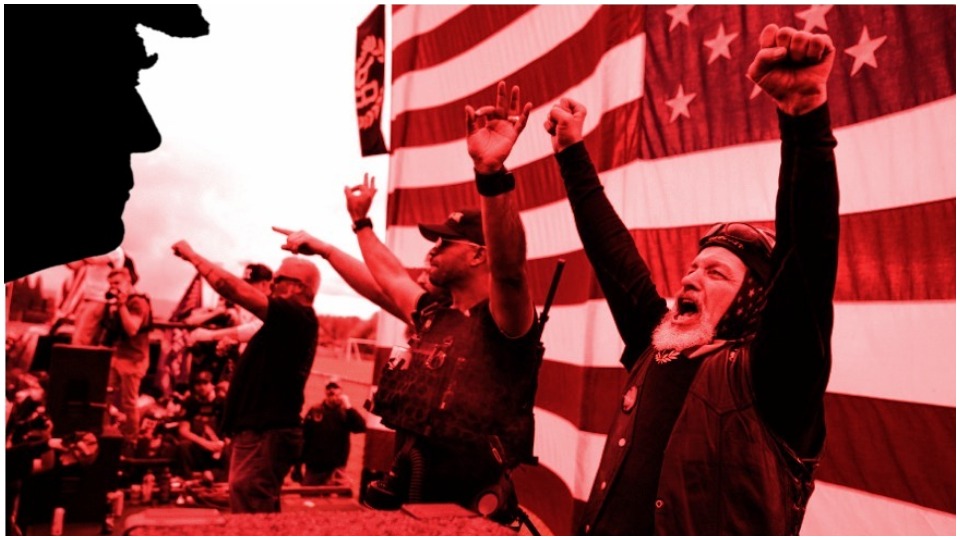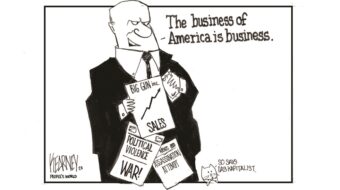
The white supremacist militia plot to kidnap Michigan Gov. Gretchen Whitmer was not a fluke. A recent report by the Department of Homeland Security (DHS) states that white supremacist groups are the single most dangerous domestic extremist threat to the nation. Despite this finding, we have a president who continues to not only refuse to fully condemn white supremacy but instead encourages its believers and invokes its rhetoric.
In the past, the ideology of white supremacy has been used to keep working people divided and brought terror to many people of color. In the present, those who follow this segment of right-wing extremism threaten the upcoming elections with violent and intimidating forms of voter suppression. In the future, society will never be able to evolve to its full potential if ideology like this is allowed the space to prosper and recruit followers. As we move into the final days of the most important election of our lifetime, we must grapple with this growing danger—asking why it continues and what threat it poses to the struggle for true democracy.

Last year was considered the deadliest for domestic extremist violence on record since the Oklahoma City bombing of 1995, according to the DHS report. White supremacists were responsible for the majority of the carnage in 2019, causing 39 out of 48 deaths and perpetuating half of the recorded lethal attacks.
2019 was perhaps the initial spark of what in 2020 has turned into a fire of ideological terror and violence. The mismanagement of the coronavirus pandemic by the Trump administration sparked unrest and economic chaos—giving white supremacist organizations the opportunity to take advantage of the situation, leading to deadly results.
White supremacy sinks its teeth into 2020 unrest
In the midst of a global pandemic that has taken the lives of over 220,000 people in the U.S., massive protests have erupted across the country in the last several months. Black Lives Matter (BLM) protests brought hundreds of thousands into the streets to demand justice against police brutality. To counter these protests, armed groups of extremists have presented themselves as unofficial extensions of law enforcement and posed as vigilante security guards. Many carry around their large rifles under the guise of protecting property only to end up being the initiators of violence.
The examples are many. Steven Ray Baca, a member of the right-wing militia group New Mexico Civil Guard, opened fire on a group of protesters after a fight broke out. This resulted in one demonstrator being shot multiple times. A Virginia man, Harry H. Rogers, who plowed his truck into a BLM crowd, was revealed to be the head of the state’s Ku Klux Klan. Kyle Rittenhouse, a 17-year-old Trump supporter, was arrested back in August for gunning down three protesters in Kenosha, Wisc. Rittenhouse had been part of a militia that claimed it was there to protect property from “looting.”
In other incidents, they are posing as anti-racist protesters in order to incite property destruction, hoping to provide “evidence” for Trump’s narrative that BLM activists are rioters and looters. The Boogaloo Bois, a far-right extremist group with many neo-Nazis, have been known to take advantage of social justice activism to cause chaos in their quest for a civil war. The Star Tribune reported this week that Ivan Harrison Hunter, a member of the Boogaloo Bois, infiltrated BLM protests in Minneapolis back in May and opened fire on the police department’s Third Precinct building with an AK-47 and screamed “Justice for Floyd” as he ran away. He has been charged with incitement to riot.
White supremacist groups are also organizing around the pandemic itself. Frustration has grown regarding the loss of jobs and living restrictions due to shutdowns. With more people at home and online, white supremacists have been recruiting at high rates on social media and message boards. Playing on far-right racist concepts and government conspiracy theories, these groups have been able to bring members around to the idea of needing to fend off a so-called “white genocide” that they claim will destroy America.
The previously mentioned scheme by the 13 white supremacists—members of the Wolverine Watchmen militia—to take Whitmer prisoner was intended to be the opening act of a race-based civil war. Just this week, it was revealed that a white man, Alexander Hillel Treisman, first arrested in May in Kannapolis, N.C., and charged with possessing child pornography, also had a van full of guns and explosives and detailed plans to assassinate Joe Biden when police seized him. Reports state that Treisman was known to say “far-right racist comments” that included wanting to murder Black people and carry out mass shootings.
One could argue these kinds of far-right threats have been on the rise for years. Studies show that there has been a dramatic increase since 2007. Yet, there is one major difference between 2007 and now—the person occupying the White House.
Trump emboldens domestic terrorists
He claims to be the “law and order president,” but Trump’s actions have shown him to promote lawlessness and turmoil. Trump’s 2016 campaign relied on the not-so-subtle message that making America “great again” meant making it great for white people. Instead of addressing the concerns of working people when it comes to poverty wages and exploitation, he lied to white working people, making them believe that their real problem was the “others.” This has not changed at all during his four years in office, and the message has now been reinvigorated in his 2020 re-election efforts.
People’s World Election Town Hall – Oct. 25th – Register here.
Hundreds of majority Black and brown immigrants remain in subpar living conditions at detention camps controlled by the Trump administration. The president painted these undocumented workers as criminals taking the jobs of (white) workers, justifying his ghastly treatment of them.
Trump has constantly called BLM protesters “thugs” and pushed a narrative that they will all riot and “destroy the beautiful suburbs,” a classic racist dog whistle. This has given white supremacist groupings the opportunity to descend into urban areas with their guns claiming to be inspired by Trump’s words to keep the order.
Since the COVID-19 shutdowns began, the president has endlessly politicized the virus. He initially tried to say the pandemic was a Democratic hoax. He soon dug his feet in on blaming China, sparking anti-Asian attacks. His tweets of “LIBERATE MINNESOTA!”, “LIBERATE MICHIGAN!”, and “LIBERATE VIRGINIA!” did not go unheard, as we would see with the kidnapping plot months later.
The president has tried to push the idea that the upcoming election is being rigged against him by so-called corrupt left forces. While leaning into far-right anti-Semitic conspiracy theories like Q-Anon, Trump has repeatedly hinted at not being willing to transfer power peacefully if he were to lose the race. As he sows seeds of doubt about the democratic process of voting, he plays right into the hands of far-right extremists who want an excuse to take up arms in what they claim is a defense of true “freedom.”
Although it wasn’t as overt as his “stand back and stand by” call-out to the neo-fascist Proud Boys on Sept. 29, Trump continued to appeal to white supremacists in the final presidential debate on Oct. 22. He tried to claim that, unlike Biden, he supposedly wasn’t a politician and that certain government agencies, like the IRS, were working against him. Trump continued to downplay the gravity of the coronavirus while spouting off unfounded conspiracy theories regarding Biden’s finances. The president was aiming to paint himself as the government outsider fighting for men like himself—white men.
This of course plays into the ideology of far-right extremists who, according to DHS, target “…politicians, and those they believe promote multi-culturalism and globalization at the expense of the WSE [white supremacist extremist] identity.” This also connects to efforts by Trump’s Labor Department to attack diversity work programs under the guise of “reverse racism” (something that does not exist) against whites.
We have a man in the highest office of government who inspires and gives a platform to domestic terrorists. Yet, while Trump exacerbates the danger, he is not the main cause of its existence. And in order to combat this danger, understanding what it really stems from is key.
Dividing working people
In times of turmoil, ideologies are often promoted that distract from the real problems of society. The radicalization of white people, often men, by an ideology that has them identifying with the social construct of their white race to the detriment of anyone outside of it has deep roots in the perpetuation of capitalism.
The United States, like all capitalist societies, has since its inception depended on the exploitation of labor to build up the economic wealth and power of its ruling class. White supremacy has played a key role, since the days of the 13 colonies, in helping create the conditions that have kept labor cheap. 
In the mid-1600s, in order to keep white and Black indentured servants from joining together to combat unfair work conditions, those in power created a legal distinction between workers in order to sow division. Poor white landowners, indentured servants, and farmers were afforded a few additional rights and privileges compared to Black servants and slaves, who of course had no rights. The wealthy elite hoped to separate the groups and make it less likely that they would ever unite in resistance. Poor whites were encouraged to identify more with rich white bosses and landowners than with their fellow workers of other races. These divisive tactics continue today.
White working men and women who get swept up into these white supremacist organizations think they’re doing it for the betterment of “their people,” not realizing that the whole idea of white supremacy is to obscure who their real people and kinfolk truly are—other working people of all races.
Trump is aware of this and plays it up to obscure the fact that he has no real plan to help workers. Yet, even when Trump is (hopefully) removed from office, activists fighting for a better world will still have to grapple with an ideology that does so much damage to that cause.
Why is the presidential race still so close even when Trump’s hate has been constantly exposed? How do we deal with the fact that too many white men and women are willing to vote for a man who has shown his contempt not only for their interests but for the safety of marginalized people? How do we push for unity against insidious hate that exploits working people of all races?
I don’t have the answers, but I do know that white supremacist extremist terror cannot be ignored. The first step is voting Trump out of office to do away with their symbol of legitimacy, but the battle won’t end there, and we have to be prepared for that.













Comments